 A diverse team of professionals collaborating around a futuristic screen displaying abstract knowledge graphs, symbolizing the future of e-learning
A diverse team of professionals collaborating around a futuristic screen displaying abstract knowledge graphs, symbolizing the future of e-learningIn 2021, a landmark report by the consulting firm McKinsey & Company sent a shockwave through the corporate world. It revealed that 87% of companies worldwide were aware they either already had a skills gap or would have one within a few years. The mandate was clear: reskill and upskill your workforce, or become obsolete. This has placed an unprecedented demand on Learning & Development (L&D) departments to create more training content, on more topics, more quickly than ever before.
Yet, the tools and processes used by most L&D teams haven't changed in a decade. A 2017 report by the Association for Talent Development (ATD) found that it takes, on average, 42 to 130 hours to produce a single hour of finished e-learning content. The result is an impossible equation: a tidal wave of demand crashing against a wall of artisanal, slow, and incredibly expensive content creation processes.
This leads to the "Content Decay Crisis." By the time a painstakingly crafted course on a new software is finally launched, the software has already been updated. The "comprehensive" sales training is obsolete a quarter after it's released. The content library becomes a museum of outdated information.
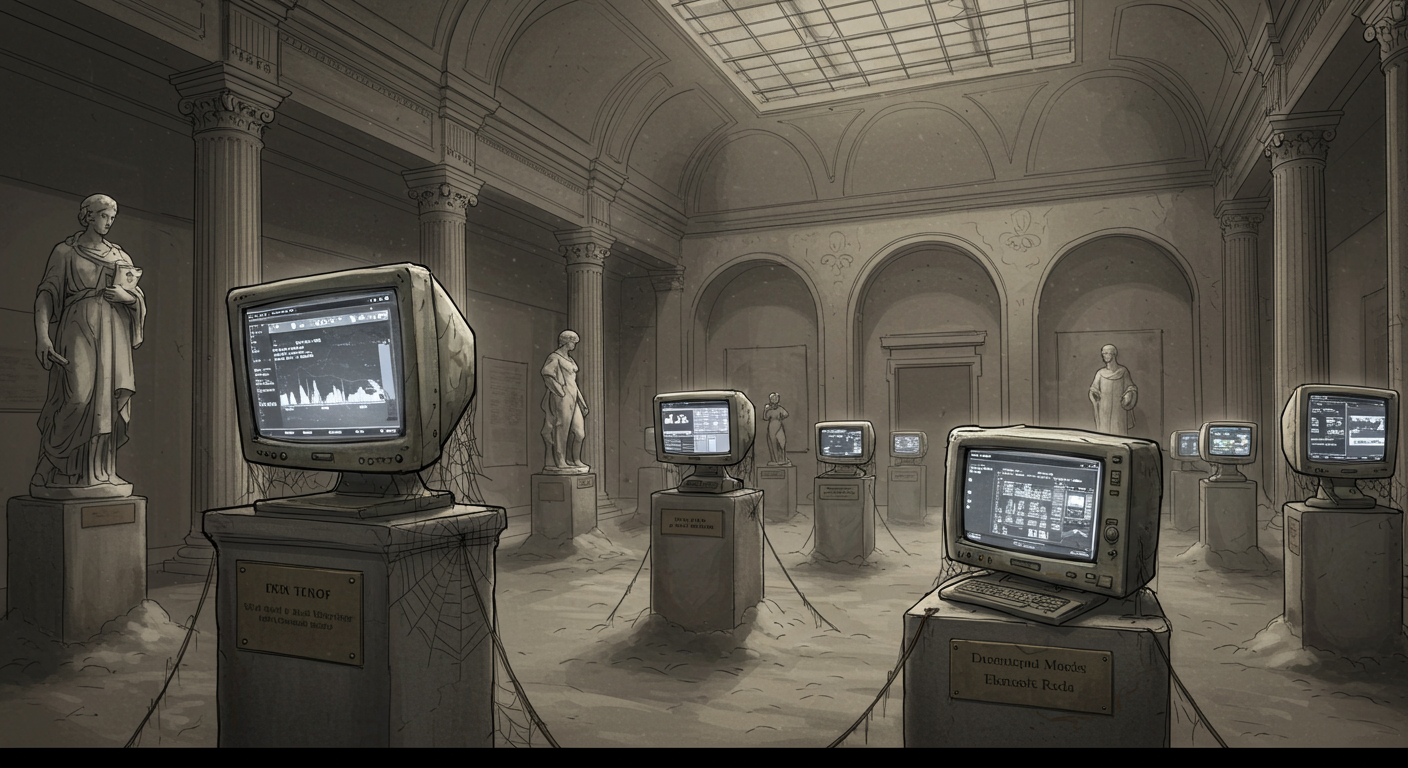
The solution is not to work harder. The solution is to build a new machine.
This is not another "how-to" guide. This is a strategic framework for L&D leaders and educators on how to move from a project-based, manual content creation model to a programmatic, AI-powered Content Engine. We will demonstrate how to assemble the AI scripting tools we've discussed into a single, integrated system that allows you to build, maintain, and scale your entire learning library with unprecedented speed and efficiency.
The Old Model vs. The New Engine: A Paradigm Shift
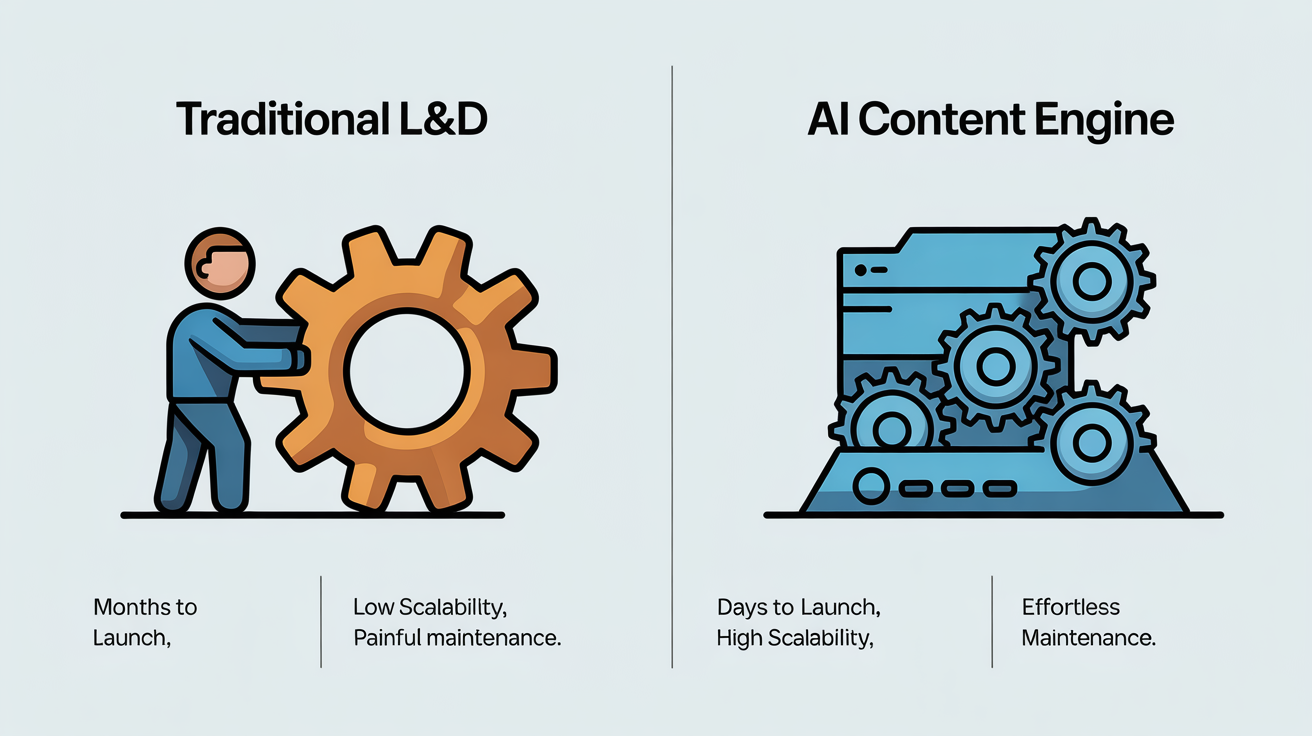
The fundamental flaw in traditional L&D is that it treats every course as a unique, handcrafted project. The new model treats the content library as a dynamic system.
| Metric | Traditional L&D Model | AI-Powered Content Engine |
| Core Process | Manual, project-based, linear. | Automated, programmatic, iterative. |
| Content Sourcing | Relies on Subject Matter Expert (SME) interviews and manual writing. | Ingests existing documents, URLs, and generates new content from prompts. |
| Speed (Time-to-Launch) | Months per course. | Weeks or even days per course. |
| Scalability | Low. Scaling requires a linear increase in headcount. | High. Can generate vast amounts of content with a small, strategic team. |
| Maintenance | Painful. Updating a course often requires a full rebuild. | Effortless. Scripts can be updated in minutes. |
| Cost Per Learning Hour | High ($1,000 - $10,000+). | Drastically Lower. |
This is a shift from being content creators to being content architects.
The AI Content Engine: A Blueprint for Your Organization
This engine has four interconnected layers. Your role as a leader is to build and manage this system, empowering your team to operate it.
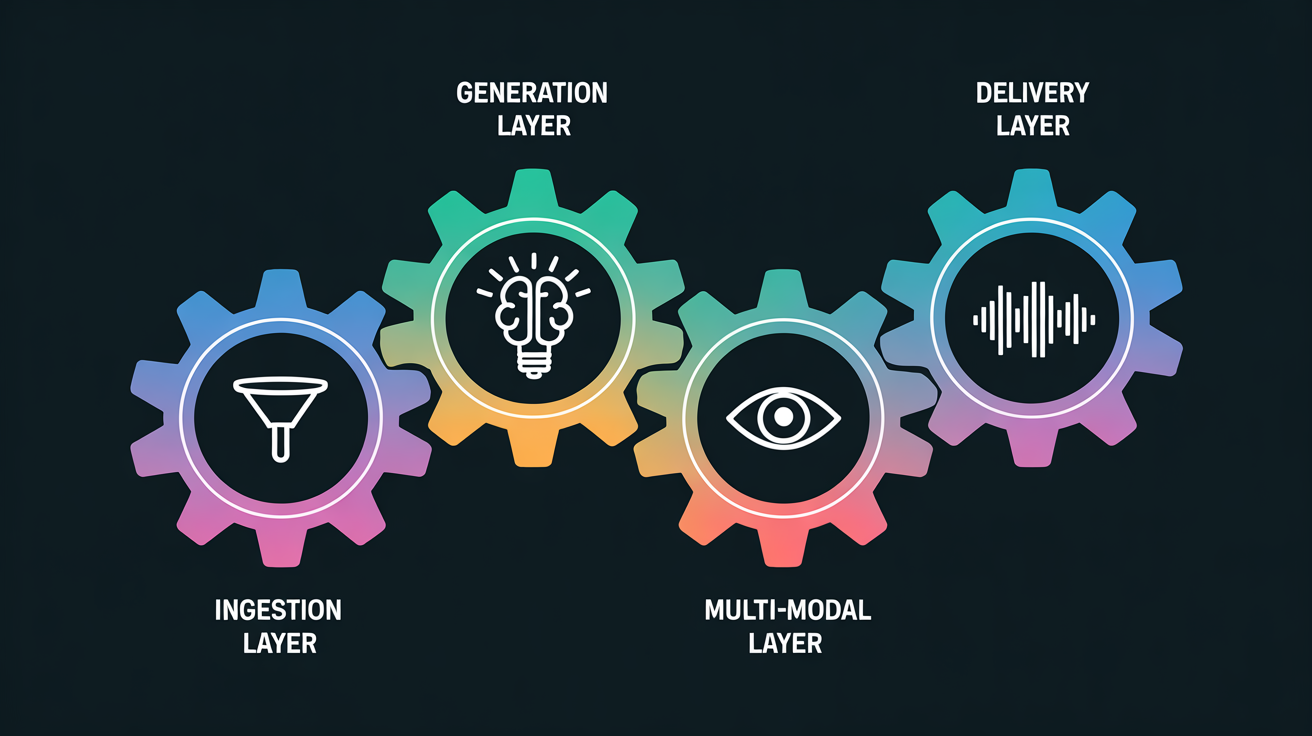
Layer 1: The Ingestion Layer (Unlocking Existing Knowledge)
Your organization's most valuable knowledge is already written down. It's in your internal wikis, your technical documentation, your SharePoint folders, and your past presentations. The first layer of the engine is designed to liberate this trapped knowledge.
- The Tools: Document-to-Script and URL-to-Script AI.
- The Strategic Workflow:
- Knowledge Audit: Your L&D team identifies the top 50 most critical internal documents (e.g., the engineering team's best practices guide, the sales team's quarterly market analysis, the HR policy manual).
- Systematic Ingestion: These documents and key external articles are fed into the AI Assistant.
- Transformation: The team uses strategic prompts to transform this raw information into foundational scripts for micro-learning modules.
- Prompt Example:"Using the uploaded 'Q3 Sales Report.pdf', create five short scripts for our sales team, each focused on a single key takeaway from the report."
- The Outcome: You have transformed your static archive into a dynamic, searchable library of foundational training scripts. You've stopped starting from zero.
FROM THE TRENCHESIn a 2023 article for Training Industry Magazine, the CLO of a major tech firm wrote, "Our biggest realization was that we were sitting on a mountain of valuable, unstructured data. Our SMEs had already written the knowledge down; it was just in the wrong format. Our AI initiative's first goal was simply to convert our top 100 internal PDFs and articles into a script library. That alone saved us an estimated 2,000 hours of development time in the first year."
Layer 2: The Generation Layer (Creating New Scenarios)
This layer is for creating content that doesn't exist yet, particularly the "soft skills" training that is so critical and so hard to teach.
- The Tools: AI Script Generator (from scratch) and AI Dialogue Generator.
- The Strategic Workflow:
- Skills Gap Analysis: The L&D team identifies a critical soft skill gap, e.g., "new managers struggle with giving negative feedback."
- Scenario Simulation: Instead of a PowerPoint, they create a library of realistic dialogue simulations.
- Prompt Example:"Create a series of five training dialogues. Each one should feature a manager giving difficult feedback to a different employee persona: the defensive high-performer, the overly agreeable but ineffective employee, the employee who gets emotional, etc."
- The Outcome: You create a "flight simulator" for difficult conversations. Your managers can now listen to and analyze these best-practice scenarios, a far more effective method than reading a bullet-point list.
Layer 3: The Multi-Modal Layer (Ensuring Accessibility)
This layer ensures that all content is accessible and engaging for all learning styles.
- The Tool: Image-to-Script AI.
- The Strategic Workflow: Your technical and process teams rely heavily on visual aids—flowcharts, diagrams, and screenshots. This layer makes that visual knowledge audible.
- Action: The L&D team integrates with the engineering department. Whenever a new system architecture diagram is finalized, it's automatically sent to the L&D team.
- Prompt Example:"Generate a clear, step-by-step audio script explaining this new system architecture for our non-technical sales team. Use an analogy to make it understandable."
- The Outcome: You bridge the knowledge gap between technical and non-technical teams, and you create a library of content that is fully accessible to employees with visual impairments.
Layer 4: The Delivery & Consistency Layer (The Voice of the Brand)
This is the final, crucial layer that unifies the entire content library.
- The Tool: AI Voice Cloning and Team Voice Management.
- The Strategic Workflow:
- Establish the "Official Voice": The organization creates a single, official "Brand Narrator" voice clone, as discussed in our "Team Voice Management" guide.
- Programmatic Application: This single voice is used to narrate all the scripts generated in the first three layers.
- The Outcome: Whether an employee is listening to a summary of a PDF, a simulated dialogue, or an explanation of a diagram, they hear the same consistent, professional, and authoritative voice. This builds a cohesive and trustworthy sonic brand for your entire L&D program.
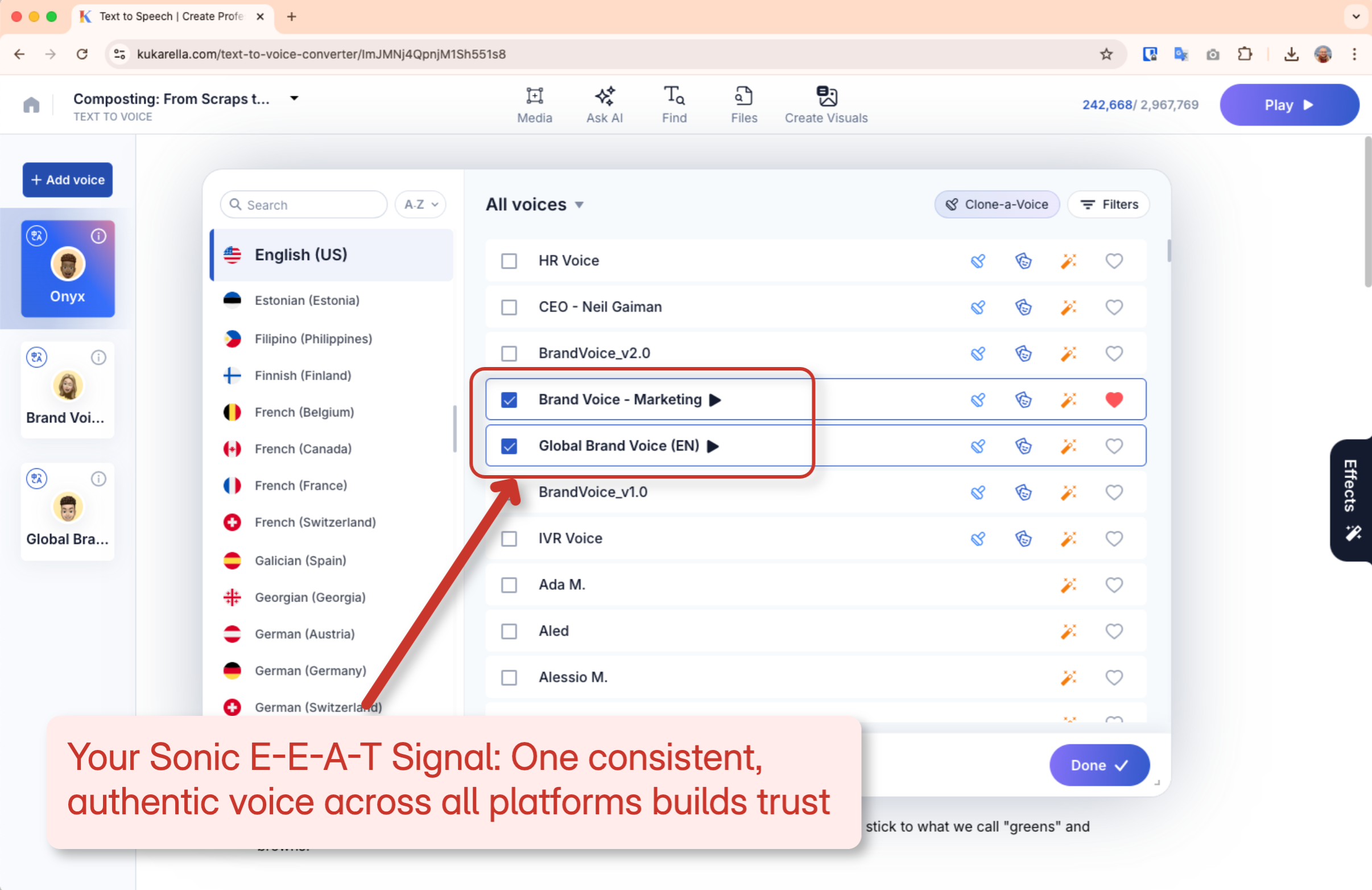
Building Your AI Content Engine: A Tool Stack Comparison
| Approach | Tools Required | Workflow Friction | Best For |
| The "Integrated Engine" | Kukarella | Low. A single platform for ingestion, generation, voice, and audio. Ensures perfect consistency. | L&D teams that need maximum speed, scalability, and brand consistency across their entire content library. |
| The "Specialized Stack" | Articulate/Vyond (Authoring) + ChatGPT (Scripting) + TTS Tool (Voice) | High. Requires multiple subscriptions and a manual, multi-step process that introduces inconsistency. | L&D teams with highly specialized needs (e.g., complex interactive video) who are willing to manage a more complex and fragmented workflow. |
"Plot Twist" Moment: The AI's Real Job Is Content Maintenance
The single biggest, unspoken cost in L&D is content decay. The effort to keep a large library of courses up-to-date is so immense that most companies simply don't do it.
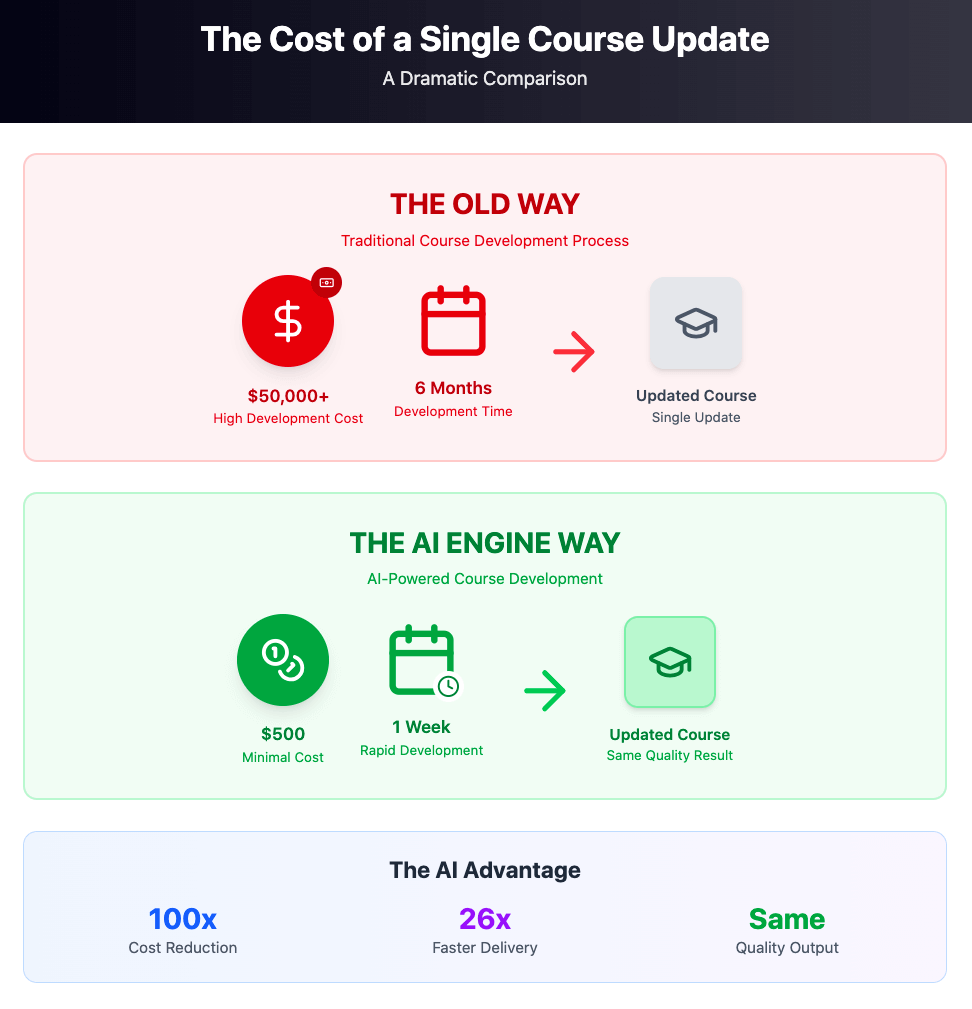
The Twist: The AI Content Engine's most profound financial impact is not in creating the first version of a course, but in creating the second, third, and fourth versions.
Because every piece of content in your library is now a text-based script, updating it is no longer a massive project.
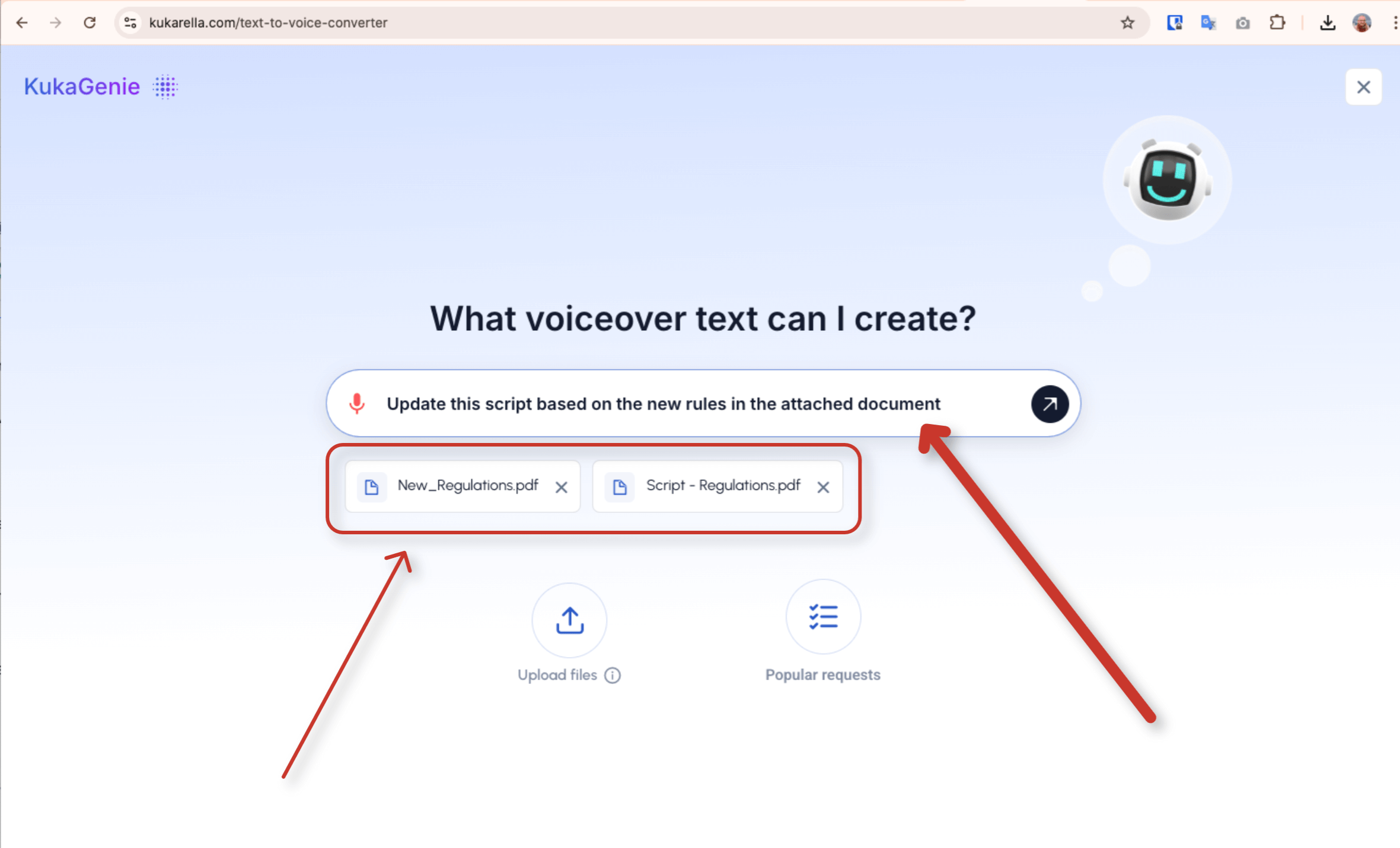
- The Scenario: A new compliance regulation is passed. Your 20-module compliance course is now out of date.
- The Old Way: A six-month, $50,000 project to re-shoot and re-record the entire course.
- The AI Engine Way:
- The legal team provides a document outlining the changes.
- The L&D team uses the AI to identify which of the 20 scripts are affected.
- They prompt the AI: "Update this script to reflect the new regulations in the attached document."
- They re-generate the audio for the affected modules with the official brand voice clone.
- The Result: The entire 20-module course is updated and compliant in under a week. Your content library transforms from a static museum into a living, breathing ecosystem of knowledge.
The Implementation Roadmap: A 90-Day Pilot Program
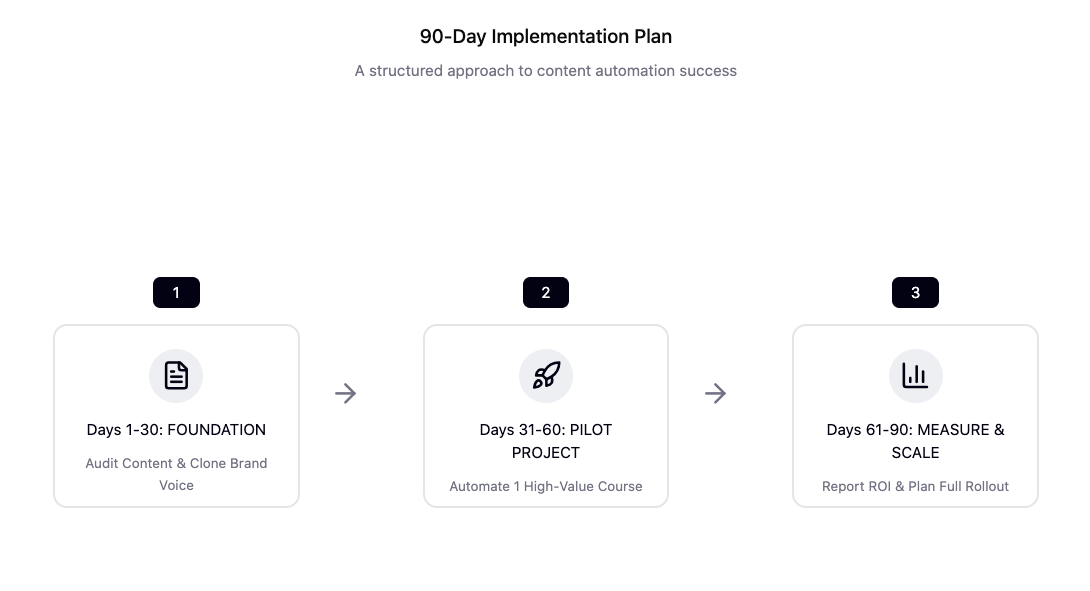
- Days 1-30: Build the Foundation.
- Choose one high-value, high-pain-point area (e.g., sales enablement).
- Perform a knowledge audit: identify the top 10 most critical documents for that team.
- Create your "Brand Narrator v1.0" voice clone.
- Use the Ingestion Layer to turn those 10 documents into foundational scripts, all voiced by your clone.
- Days 31-60: Focus on a High-Value Skill.
- Identify one critical soft skill for that team (e.g., objection handling).
- Use the Generation Layer to create a 5-part dialogue simulation series for that skill.
- Voice it and release it to the team.
- Days 61-90: Measure and Report.
- Track the KPIs: How many hours were saved compared to the old way? How is the team engaging with the new audio content?
- Survey the team: Did they find the content more useful and engaging?
- Present this data to leadership to get buy-in for a full-scale rollout.
The demand for continuous learning will only accelerate. The organizations that thrive will be those that can create and disseminate knowledge at the speed of business. An AI-powered Content Engine is no longer a futuristic luxury; it is the essential infrastructure for the modern learning organization.